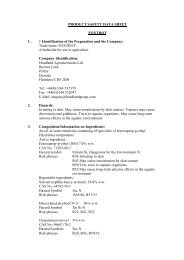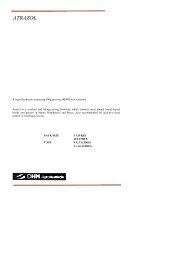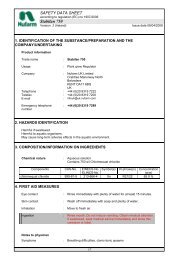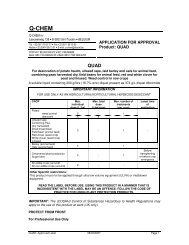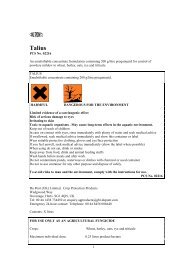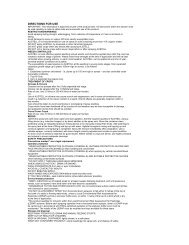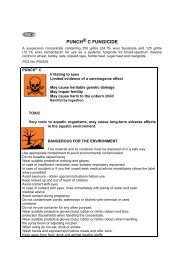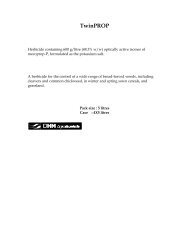K2 - Dhm.ie
K2 - Dhm.ie
K2 - Dhm.ie
Create successful ePaper yourself
Turn your PDF publications into a flip-book with our unique Google optimized e-Paper software.
<strong>K2</strong><br />
GENERAL COMMENTS : ‘The effects of <strong>K2</strong> on plant growth can result in y<strong>ie</strong>ld increase and a<br />
reduction in early lodging from a spring application. This control of lodging is more consistent in wheat<br />
than in barley.’<br />
TIME OF APPLICATION TO AUTUMN SOWN CROPS (WHEAT AND BARLEY)<br />
Apply <strong>K2</strong> during tillering, but not later than leaf sheath erect stage (when the leaf sheaths on half of the<br />
main shoots have reached 5cm (2") measured from ground level to the base of the uppermost leaf blade)<br />
but before the first node is detectable (Zadoks 31). This is likely to be between mid-February and mid-<br />
April. Best results have been obtained from applications made before the end of March in all autumn<br />
sown crops.<br />
TIME OF APPLICATION TO SPRING SOWN CROPS (WHEAT ONLY)<br />
Apply <strong>K2</strong> during tillering, but before the first node is detectable on half of the main stems. This will<br />
usually mean treating the crop between 15 and 35 days after 50% emergence, especially in late drilled<br />
spring crops.<br />
RATE OF APPLICATION<br />
WINTER WHEAT Apply <strong>K2</strong> at 1.0 litres per hectare (0.7 pints per acre)<br />
SPRING WHEAT Apply <strong>K2</strong> at 0.9 litres per hectare (0.64 pints per acre)<br />
WINTER BARLEY Apply <strong>K2</strong> at 1.25 litres per hectare (0.9 pints per acre)<br />
APPLICATION VOLUME<br />
Apply the recommended rate of <strong>K2</strong> in at least 200 litres of water per hectare (18 gallons per acre).<br />
MIXING<br />
Shake well before use. Add <strong>K2</strong> to a half-filled tank. Top up tank to the required volume and ensure<br />
thorough mixing before and during spraying.<br />
CAUTION<br />
Do not use in tank mixture with liquid nitrogen fertiliser.<br />
APPLICATION CONDITIONS<br />
Do not apply <strong>K2</strong> to crops under stress from waterlogging, drought, or nutr<strong>ie</strong>nt defic<strong>ie</strong>ncy. In hot, dry<br />
weather a better result might be obtained from application in the early morning or evening.<br />
CAUTION<br />
Although <strong>K2</strong> may be used under normal seasonal temperature (down to 1° C) and ground conditions, it<br />
should not be sprayed onto plants covered with frost and requires two hours before rain or frost occurs<br />
for a good effect to be obtained. Do not allow <strong>K2</strong> to drift onto neighbouring crops.<br />
UNDERSOWN CROPS<br />
<strong>K2</strong> may be used on crops undersown with clovers and grasses.<br />
VARIETAL RESTRICTIONS<br />
There are no var<strong>ie</strong>tal restrictions on the use of <strong>K2</strong><br />
SEED CROPS<br />
<strong>K2</strong> may be used on all var<strong>ie</strong>t<strong>ie</strong>s of wheat and barley grown under the Seed Certification Scheme but<br />
growers are advised to consult the guidelines laid down in the Seed Certification Scheme’s<br />
“Certification of Seed of Wheat, Barley and Oats”.



